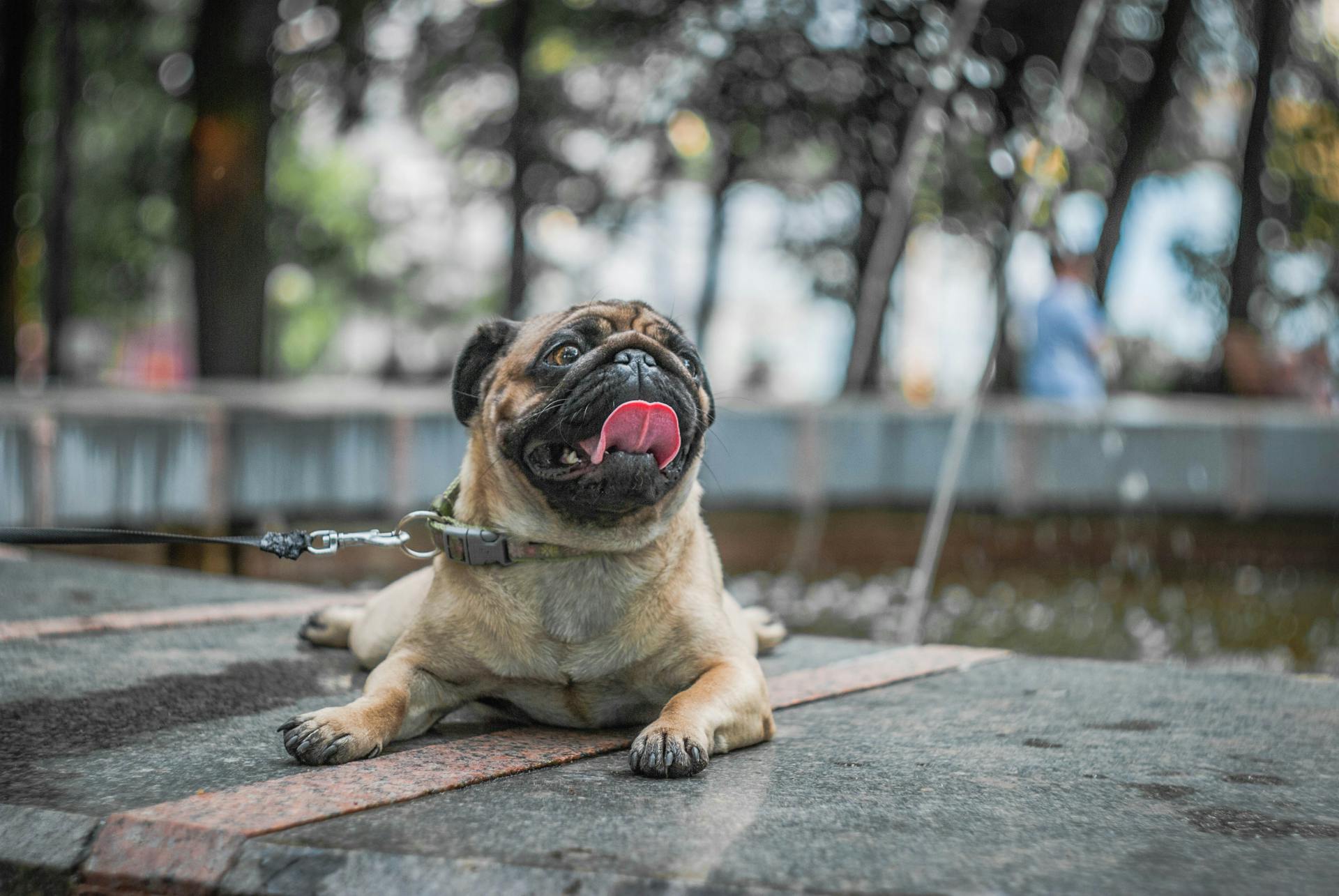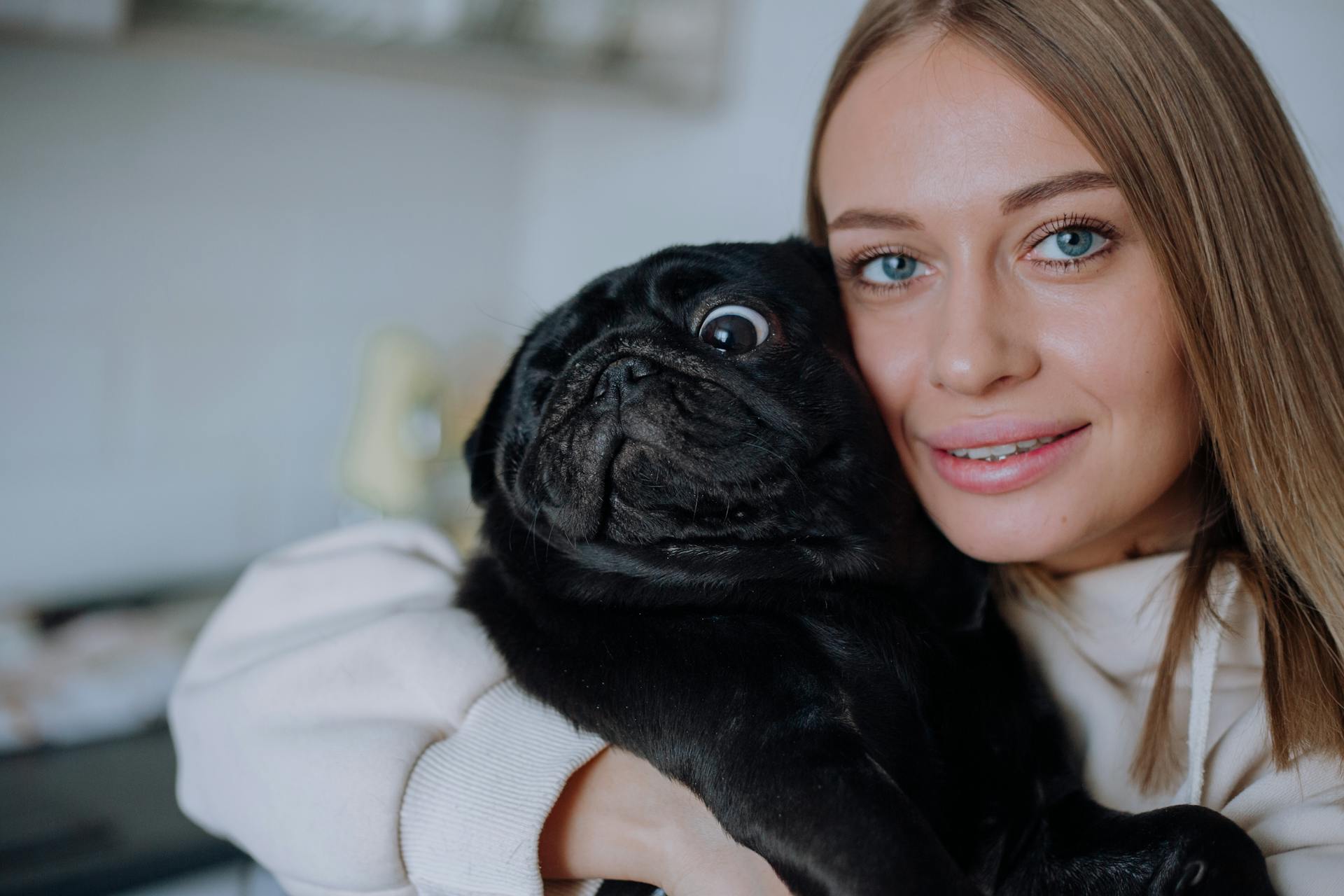
Pug dog eyes are adorable, but they can also be prone to health issues. One of the most common problems is cherry eye, a condition where the gland in the third eyelid becomes inflamed and protrudes from the eye.
This can be caused by a weak or underdeveloped gland, which is more common in pugs due to their brachycephalic skull structure. Pugs are also more likely to develop ectropion, a condition where the eyelid turns outward, exposing the eye to dust and debris.
Regular cleaning of the eyes is crucial to prevent infections and irritation. You can use a damp cloth to gently wipe away any dirt or debris that accumulates around the eyes.
Causes of Red and Bulging Eyes
Red and bulging eyes in pugs are often a sign of underlying causes that can be treated with surgery, antibiotics, or other medical interventions.
Some common causes include infections, glaucoma, and injuries to the eye area.
Bacterial or tick-borne infections may require long courses of antibiotics, while glaucoma is typically a chronic, lifelong disease unless it's caused by another correctable disorder.
Pugs and other brachycephalic breeds are prone to eye problems due to their shortened skulls, which can cause their eyes to appear bulging or protruding.
To prevent trauma or injury to your pug's eyes, use harnesses instead of collars and avoid areas with long, dry grasses and potential foxtails.
Causes of Red
Allergies are a common cause of red eyes in dogs, often accompanied by sneezing, runny nose, or watery eyes.
If your dog has allergies, your vet may recommend regular allergy medication or a shorter course of eye drops to treat any allergic flare-ups.
A foreign object stuck in your dog's eye can also cause redness and discomfort, similar to when we get a piece of dirt or an eyelash trapped in our eye.
Removing the object usually resolves the issue, but in some cases, the object can cause scratching or damage that needs to be treated by a vet.
Curious to learn more? Check out: Vets Dog Treats
Pinkeye, also known as conjunctivitis, is a condition that causes a dog's eye to turn red or pink and become irritated and inflamed, often accompanied by pain, itching, swelling, and crust or drainage from the eye.
Medicated eye drops can easily treat pinkeye, but in severe cases, your vet may also recommend oral medication to help clear up the problem quickly.
Causes of Bulging
Bulging eyes in dogs can be caused by various underlying issues, each with its own unique characteristics.
Some diseases or infections can lead to bulging eyes, and recovery depends on the specific condition and treatment received.
Surgery can resolve issues more quickly than other diseases or infections, but some cases may require long courses of antibiotics.
Glaucoma is typically a chronic, lifelong disease unless it's secondary to another disorder that can be corrected.
Pugs and similar breeds have an abnormally shortened skull due to breeding, which can put them at risk for eye-related issues.
Their flat, wide faces mean their eyes don't sit as far back into the eye sockets, giving the appearance of bulging eyes.
This increased pressure can cause their eyes to pop out, even with a small amount of force, such as when pulling on a leash too hard.
If this caught your attention, see: Types of Dog Eye Infections
Diagnosis and Treatment
To diagnose bulging eyes in dogs, veterinarians will do a complete history and physical examination, plus an eye examination that includes an intraocular pressure check for glaucoma and a fluorescein test to check for corneal ulcers.
The veterinarian will also evaluate the associated muscles and soft tissue for any damage to determine the best course of treatment. Surgery is often needed to treat bulging eyes, and the type of surgery depends on the extent of the damage.
In some cases, the eye can be replaced into the socket at the time of surgery, but this requires the eyeball to be intact.
How Veterinarians Diagnose
To diagnose a condition, veterinarians typically start by doing a complete history and physical examination. They'll ask about the dog's symptoms, medical history, and lifestyle to get a better understanding of what's going on.
A thorough physical examination is crucial, as it can reveal underlying issues that might be contributing to the problem.
Veterinarians will also perform an eye examination, which is essential for diagnosing eye-related conditions.
An intraocular pressure check is a key part of the eye examination, especially for glaucoma.
A fluorescein test is used to check for corneal ulcers, which can cause bulging eyes in dogs.
Treatment Options

Surgery is often necessary to treat a Pug's eye that has popped out, and the type of trauma and damage will determine the best course of action.
Your veterinarian will evaluate the eye, associated muscles, and soft tissue to determine if the eye can be saved or not.
In almost all cases, surgery is needed to repair the damage.
The surgery may involve replacing the eye into the socket, with sutures to keep it in place while the wounds heal and swelling resolves.
This procedure requires the eyeball to be intact.
Surgery may also involve removing the eye and some associated tissues, which is often necessary due to the severity of the trauma.
The optimal age for performing surgery to correct medial canthal entropion is between 7-10 months, as this is when first corneal lesions typically appear.
This age range is crucial for preventing further complications and promoting healing.
Recovery and Prevention
Recovery from bulging eyes in pugs depends on the underlying cause and treatment. If your pug needs surgery, recovery will be faster than if they have a bacterial or tick-borne infection that requires long-term antibiotics.
Preventing trauma or injury to your pug's eyes is key. Use a harness instead of a collar on short-nosed pugs, as collars can cause discomfort and potentially lead to eye problems.
To prevent bulging eyes in pugs, avoid breeding dogs with known inherited medical issues. Regular veterinary check-ups are also crucial – get your pug to the vet as soon as you notice any squinting, redness, or discharge from their eye(s).
Here are some practical tips to prevent eye injuries in pugs:
- Use harnesses instead of collars on short-nosed pugs.
- Avoid areas with long, dry grasses that can harbor foxtails.
Bulging Recovery and Management
Recovery from bulging eyes in dogs depends on the underlying cause and treatment.
Some issues can be resolved more quickly with surgery, but other diseases or infections may require long courses of antibiotics.
Glaucoma is typically a chronic, lifelong disease unless it's secondary to another correctable disorder, such as an infection or lens luxation.
A dog's recovery from bulging eyes will depend on the effectiveness of its treatment.
Recovery time can vary significantly depending on the underlying cause and the dog's response to treatment.
Take a look at this: What to Do with Your Dog's Ashes?
Prevention of Bulging

Prevention of bulging eyes in dogs is crucial to avoid the issue altogether. Using harnesses instead of collars on short-nosed (brachycephalic) dogs can help prevent trauma or injury to your pup's eyes.
You should also be mindful of the areas where your dog plays or runs. Avoid letting them play or run in areas with long, dry grasses that have potential foxtails, as these can cause eye problems.
Don't breed dogs that have had known inherited medical issues, as this can increase the risk of eye problems in your pup.
If you notice any signs of eye issues in your dog, such as squinting, redness, or discharge, get them to the vet as soon as possible. Your vet would rather see a dog before the eye is bulging, when it's easier and less expensive to treat.
Here are some key prevention tips to keep in mind:
- Use harnesses instead of collars on short-nosed (brachycephalic) dogs.
- Avoid areas with long, dry grasses that have potential foxtails.
- Don't breed dogs with known inherited medical issues.
- Get your dog to the vet if you notice any eye issues.
Recognizing and Reacting to the Problem
If you're a pug owner, it's essential to be aware of the potential issues with your dog's eyes. If you're a pug owner, consider that your dog certainly has medial entropy or ocular syndrome of brachiocephalic breeds.
You can easily spot the problem by evaluating your pet's eyes with a bright source of light. Take your pet and shine a light on its eyes, starting by carefully observing the edge of the lower eyelid along the nasal fold.
The eyelid hairs will rub the cornea, and the eyelid margin of the lower eyelid will be very thin until it almost completely disappears where the lower eyelid joins the upper eyelid. Compare it to the cornea along the lateral edge of the eyelid (the edge facing the ear).
The sooner you notice a problem, the sooner you'll be able to resolve it. The success of treatment primarily depends on the stage of the pathological processes.
If your pug suffers from any sort of trauma and/or if one or both of their eyes pop out, you need to seek immediate veterinary care. First and foremost, if your dog was bitten by another animal and this is what caused the injury to the eye, any other bite wounds also need to be addressed.
Your veterinarian will evaluate your pug's eyes, in addition to any other trauma to the body that occurred. They will then discuss treatment options with you.
Frequently Asked Questions
What should Pugs eyes look like?
Pugs' eyes appear bulging due to their shortened skull, but are actually normal in size. They sit closer to the eye sockets than usual, giving the appearance of protrusion.
What to do if Pugs eye pops out?
Seek immediate veterinary attention if your Pug's eye pops out, as prompt treatment is crucial to prevent complications. The sooner your dog receives medical care, the better the chances of a successful repositioning
Sources
- https://veterinaryemergencygroup.com/blog/why-are-my-dogs-eyes-red-top-6-reasons/
- https://www.petmd.com/dog/conditions/eyes/bulging-eyes-dogs
- https://oculus-vet.com/en/medial-canthal-entropion-in-pugs/
- https://pugdogpassion.com/eyes-brachycephalic-ocular-syndrome/
- https://www.dogster.com/ask-the-vet/can-pugs-eyes-pop-out
Featured Images: pexels.com


